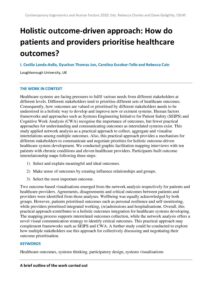| Document | Author I. Cecilia Landa-Avila, Gyuchan Thomas Jun, Carolina Escobar-Tello and Rebecca Cain |
| Abstract Healthcare systems are facing pressures to fulfil various needs from different stakeholders at different levels. Different stakeholders tend to prioritise different sets of healthcare outcomes. Consequently, how outcomes are valued or prioritised by different stakeholders needs to be understood in a holistic way to develop and improve new or existent systems. Human factors frameworks and approaches such as Systems Engineering Initiative for Patient Safety (SEIPS) and Cognitive Work Analysis (CWA) recognise the importance of outcomes, but fewer practical approaches for understanding and communicating outcomes as interrelated systems exist. This study applied network analysis as a practical approach to collect, aggregate and visualise interrelations among multiple outcomes. Also, this practical approach provides a mechanism for different stakeholders to communicate and negotiate priorities for holistic outcome-driven healthcare system development. We conducted graphic facilitation mapping interviews with ten patients with chronic conditions and eleven healthcare providers. Participants built outcome interrelationship maps following three steps: 1) Select and explain meaningful and ideal outcomes. 2) Make sense of outcomes by creating influence relationships and groups. 3) Select the most important outcome. Two outcome-based visualisations emerged from the network analysis respectively for patients and healthcare providers. Agreements, disagreements and critical outcomes between patients and providers were identified from those analyses. Wellbeing was equally acknowledged by both groups. However, patients prioritised outcomes such as personal resilience and self-monitoring, while providers prioritised integrated working, (re)admissions and hospitalisations. Overall, this practical approach contributes to a holistic outcomes integration for healthcare systems developing. The mapping process supports interrelated outcomes collection, while the network analysis offers a novel visual communication strategy to identify critical outcomes. This practical approach may complement frameworks such as SEIPS and CWA. A further study could be conducted to explore how multiple stakeholders use this approach for collectively discussing and negotiating their outcome prioritisation. |

